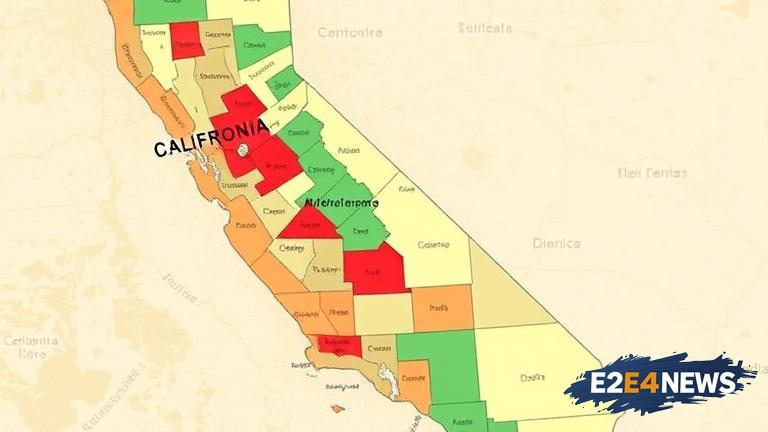The state of California has been at the center of a heated debate over its congressional map, with some critics, including Vance, claiming that it is a prime example of Democratic gerrymandering. Gerrymandering, the practice of manipulating electoral district boundaries for political gain, is a contentious issue that has sparked intense debate across the United States. In the case of California, the allegations of gerrymandering stem from the state’s newly redrawn congressional map, which was approved by the California Citizens Redistricting Commission in 2021. The map has been criticized for allegedly favoring Democratic candidates and disenfranchising Republican voters. However, supporters of the map argue that it is a fair and balanced representation of the state’s diverse population. To understand the issue, it is essential to examine the redistricting process in California and how the new map was created. The California Citizens Redistricting Commission is an independent body tasked with redrawing the state’s congressional and legislative districts every ten years. The commission is composed of 14 members, five from each of the two major parties and four from neither party. The commission uses a variety of criteria to draw the district boundaries, including population equality, geographic compactness, and respect for communities of interest. Despite the commission’s efforts to create a fair and balanced map, critics argue that the final product is biased towards Democratic candidates. One of the primary concerns is that the map splits several Republican-leaning districts, making it more difficult for Republican candidates to win. For example, the new map divides the city of Orange County into multiple districts, potentially diluting the Republican vote. Additionally, some critics argue that the map packs Democratic voters into a few districts, making it easier for Democratic candidates to win. However, supporters of the map counter that these changes were necessary to reflect the state’s shifting population and demographic trends. They argue that the map is a more accurate representation of California’s diverse population and that it provides greater opportunities for underrepresented communities to elect candidates of their choice. The debate over California’s congressional map is not just a local issue; it has implications for the national political landscape. The allegations of gerrymandering have sparked a wider conversation about the role of redistricting in shaping American politics. As the country approaches the next census and redistricting cycle, the issue of gerrymandering is likely to become even more pressing. In conclusion, the allegations of Democratic gerrymandering in California’s congressional map are complex and multifaceted. While critics argue that the map is biased towards Democratic candidates, supporters contend that it is a fair and balanced representation of the state’s population. Ultimately, the issue will likely be decided in the courts, where the map’s constitutionality will be tested. The outcome of this debate will have significant implications for the future of American politics and the role of redistricting in shaping the country’s electoral landscape. The controversy surrounding California’s congressional map serves as a reminder of the importance of fair and transparent redistricting processes. As the United States continues to grapple with the challenges of gerrymandering, it is essential to prioritize the principles of democracy and ensure that electoral districts are drawn in a way that reflects the will of the people. The debate over California’s congressional map is a microcosm of the larger national conversation about the role of politics in shaping American democracy. As the country moves forward, it is crucial to address the issue of gerrymandering and work towards creating a more fair and representative electoral system. The allegations of gerrymandering in California’s congressional map have sparked a heated debate about the integrity of the state’s electoral system. The controversy has raised important questions about the role of politics in shaping American democracy and the need for fair and transparent redistricting processes. As the issue continues to unfold, it is essential to prioritize the principles of democracy and ensure that electoral districts are drawn in a way that reflects the will of the people. The outcome of this debate will have significant implications for the future of American politics and the role of redistricting in shaping the country’s electoral landscape. The controversy surrounding California’s congressional map serves as a reminder of the importance of fair and transparent redistricting processes and the need to address the issue of gerrymandering. The debate over California’s congressional map is a complex and multifaceted issue that requires careful consideration of the facts and the principles of democracy. As the country continues to grapple with the challenges of gerrymandering, it is essential to prioritize the principles of democracy and ensure that electoral districts are drawn in a way that reflects the will of the people. The allegations of Democratic gerrymandering in California’s congressional map are a reminder of the importance of fair and transparent redistricting processes and the need to address the issue of gerrymandering. The controversy surrounding California’s congressional map serves as a reminder of the importance of prioritizing the principles of democracy and ensuring that electoral districts are drawn in a way that reflects the will of the people. The debate over California’s congressional map is a microcosm of the larger national conversation about the role of politics in shaping American democracy. As the country moves forward, it is crucial to address the issue of gerrymandering and work towards creating a more fair and representative electoral system. The allegations of gerrymandering in California’s congressional map have sparked a heated debate about the integrity of the state’s electoral system. The controversy has raised important questions about the role of politics in shaping American democracy and the need for fair and transparent redistricting processes. The outcome of this debate will have significant implications for the future of American politics and the role of redistricting in shaping the country’s electoral landscape.





